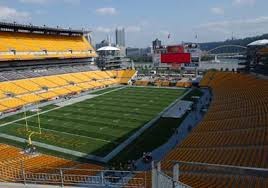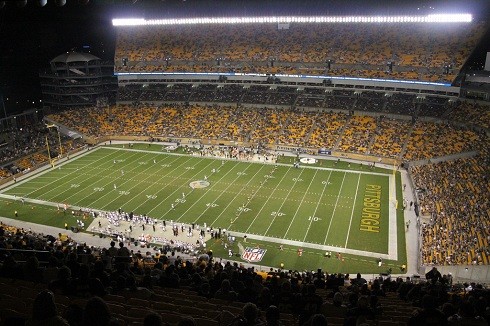Heinz Field
Introduction
Text-to-speech Audio
Images
Heinz Field is the home of the Pittsburgh Steelers NFL team and the University of Pittsburgh football team. It was built in 2001.

Overhead view of the stadium at night.

Backstory and Context
Text-to-speech Audio
The enormous 1.5 million square foot Heinz Field Stadium stands on the banks of the Ohio River in the Northside neighborhood of Pittsburgh. The stadium was built 65 feet away from where its predecessor, Three Rivers Stadium, had stood for thirty years. The “U-shaped” facility features large spiral stairways and one of the NFL's largest scoreboards at its open end. From a base of precast stone, an exposed steel structure rises as a nod to the local steel industry. The stadium's upper decks are supported by distinctive yellow structural members in groups of four, which are nicknamed “quad pods.”' Tapering steel columnns support the lower decks, and glass curtain walls enclose two, three-story club lounges. The stadium can accommodate 65,000 seats, about 7,000 club seats, and also offers 130 luxury suites which are leased with seating for more than 1,500 fans. Heinz field was designed by HOK Sports and construction was finished in 2001. The stadium is comprised of 12,000 tons of steel, 48,000 cubic yards of concrete, 50,000 square feet of glass, and 7 miles of railing. The playing surface is a blend of four varieties of Kentucky Bluegrass, covering just over two acres. About 40 miles of piping exist under the turf, acting as a heating element.
Heinz Field was part of a revitalization project of the area and would be accompanied by the construction of PNC Park and the David L. Lawrence Convention Center. The plans for these projects were approved on July 9, 1998, by the Allegheny Regional Asset District Board. Originally, $233 million was budgeted to Heinz Field, however, the Steelers pledged $76.5 million and promised to remain a Pittsburgh team until 2031. As the name suggests, the Heinz Ketchup Company bought naming rights of the stadium in June 2001 for the price of $57 million. The overall cost of Heinz Field was $281 million. Although that price may seem like a lot, the stadium has not seen many struggles, as it has sold out every home game since it has been constructed and has hosted a number of other popular events that bring in a large amount of revenue.
Along with hosting the Pittsburgh Steelers and the University of Pittsburgh Panthers football teams, Heinz Field has also seen a number of other events, such as concerts and even other sporting events. The first event to be held at the stadium was an N’Sync concert on August 18th, 2001. The stadium has seen 16 concerts to date, which brought an average revenue of around $4 million for each concert. On July 27th, 2014, Heinz Field hosted an international soccer match between AC Milan and Manchester City for the 2014 International Champions Cup which saw about 34,000 spectators. The field also was selected to be the venue for the 2011 Winter Classic hockey game between the Pittsburgh Penguins and the Washington Capitals. The first official football game played in the stadium was between the Pittsburgh Panthers and East Tennessee State, on September 1, where the Pitt Panthers won the game 31–0. The first official NFL game at the stadium was scheduled for September 16th, but due to the September 11th terror attacks in New York, all NFL games were postponed for the week. The Steelers' home opener was against the Cincinnati Bengals in October 2001.
The Steelers franchise was founded by Arthur J. Rooney on July 8, 1933, and is the seventh oldest franchise in the NFL. The team’s name was originally the Pirates but switched to the Steelers in 1940. The team has played in four stadiums since their start in 1933. The first game the Steelers played in the NFL was on September 20th against the New York Giants at Forbes Field, which at the time was the Steelers’ home field. Moving to Pitt Stadium in 1958, The team struggled for their first 40 years without winning a championship of any kind until they won the AFC Central division title in 1972 at their Three Rivers Stadium. The Steelers began a new decade in a new conference and a new stadium with a new quarterback. After so many years of frustration, the 1970s Steelers began one of the most incredible streaks in sports history when they earned eight consecutive playoff appearances, seven AFC Central titles, and four AFC championships from 1972 to 1979. The Steelers became the first team to win four Super Bowls and the only team to win back-to-back Super Bowls twice. After the AFL-NFL merger, the Steelers kept looking better and better. They became the third team to win five Super Bowls after they defeated the Seattle Seahawks in Super Bowl XL. In 2005, Bill Cowher’s Steelers became the first wild-card team in history to win three playoff road games and the Super Bowl. After the 2006 season, Bill Cowher resigned and was replaced by Mike Tomlin, who in his second season led the team to victory in Super Bowl XLIII, which marked their sixth championship in franchise history as the Steelers became the first team to win six Super Bowls. The Steelers moved into Heinz Field when it was completed in 2001. The stadium is also home to the Pitt Panthers of the University of Pittsburgh.
The Pittsburgh Panthers football team began humbly in 1889 when the University was still known as the Western University of Pennsylvania. In 1904, WUP completed its first true football season, finishing 10-0 which is an impressive record for being their first season. In the years 1915-1923, under Glenn Scobey "Pop" Warner’s coaching, the Panthers achieved a record of 60 wins, 12 losses, and 4 ties. Warner would also coach three Pitt teams to championship seasons in 1915, 1916, and 1918. Jock Sutherland coached the Panthers from 1928 to 1934 and achieved an impressive 111–20–12 record. Sutherland led the Panthers to four Rose Bowl appearances, five national championships, and seven eastern championships.
Not only were the Panthers winning many games, they also had won a major victory off the field during the 1956 Sugar Bowl. At the time, segregation was a huge issue in the United States and the Panthers were given a tough choice, bench their fullback Robfullbacky” Grier, who was an African American, or Georgia would forfeit the game. The Governor of Georgia strongly opposed Grier's participation in the game, as did the Board of Trustees from Georgia Tech, who claimed that Georgia Tech would elect to forfeit the game if Grier was not benched but Pittsburgh answered back with, “No Grier, no game.” In the end, Pitt lost to Georgia but the color barrier would be forever broken with Grier’s courage to play in the game. He became the first African American to play in the Sugar Bowl in New Orleans on January 2, 1956.
Although Heinz Field is only 16 years old, there is so much history involved with it. Outside of football, the people that have played there, either in sport or by music, have a rich history that they have, in some way, shared with Heinz Field. The Steelers and the Panthers from their very beginnings have been Pittsburgh teams and they have brought their past experiences with them as they moved into their newest field. The Steelers already have promised to remain at the field until 2031, but I am hoping that even if they end up moving to a new venue in the future, they will bring the rich history of their football throughout the rest of time.
Sources
"Pittsburgh Steelers." Sports Encyclopedia. Accessed February 3, 2015. http://www.sportsecyclopedia.com/nfl/pitt/steelers.html.
Zhuang, Zhe. "Heinz Field Case Study." June 2010. https://www.cmu.edu/steinbrenner/brownfields/Case%20Studies/pdf/heinz-field.pdf.
